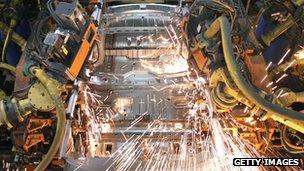The decline of US manufacturing jobs and living standards
- Published

For decades America's vibrant manufacturing sector provided poorly educated workers a bridge to the middle class. But today's plants need highly skilled workers who know their way around ultra-high tech machinery.
On the factory floor of AMI, a Michigan-based maker of fuel cells, one can hear the future of manufacturing.
It is very, very quiet.
The loudest noise in the brightly lit factory is the beeping of a hydraulic lift used to replace lightbulbs overhead.
The contrast with traditional manufacturing is sharp: Almost no noise, no dirt, little physical effort. And requirements for workers are very different.
"You've got to have the smart people that help build it from the bottom up," says AMI President Aaron Crum.
"We don't forge things anymore. We use lasers to cut metal, we extrude ceramics, we do things that are different. And so because of it, we need a different labour force to make it happen."
Decades of losses
Manufacturing in the US is undergoing the same technological revolution that sent workers from agriculture to industry at the end of the 19th Century, says Lou Glazer of consulting group Michigan Future Inc.
In the '50s, he says, factory work was a third of the work in America; now it's below 10%.
Although manufacturing employment has ticked up in recent months, adding 30,000 jobs since March, the gains pale in comparison to the losses of the past decade.
Three and half million manufacturing jobs have vanished in 10 years, bringing the current total to just under 12 million.
As employment has plummeted, productivity has soared. Not for nothing does the US National Association of Manufacturers boast that American factory workers are "the most productive in the world".
About 30 minutes' drive from the AMI plant is the ghost of manufacturing past: Willow Run.
It is an almost unfeasibly large plant that once turned out Liberator bombers, then Kaiser cars, then transmissions and car bodies for General Motors.
Willow Run closed in 2010 when GM went bankrupt. Of the plant's five million square feet, one million has been cleared for sale.
The rest of the factory is an astonishing reminder of what manufacturing used to be like.
Hulking presses the size of three-storey houses gather dust, corridors stretch into the gloom seemingly without end, and the warm air is thick with the smell of machine oil.
'No diploma needed'
Gathered round a table at a nearby diner, former Willow Run workers remember their first days at the plant. Now in their 50s, they reminisce about what it took to get a job at the plant.
"You didn't need a high school diploma," says Sterling Mullins.
"You just needed to be a hard worker," says Gerry Gardner, "and you needed to show up every day, because it wasn't easy work."
Tom White grew up on a farm, "so the skills I had weren't really applicable".
Those were the days when manufacturing lifted poorly educated men and put them into America's industrial middle class.
"You could put the kids through college, we had a couple of weeks vacation," Mr Gardner says.
"And you had enough money to go out and buy a new car. We weren't rich - I'm not driving no Rolls Royce or anything - but I bought me a GM car."
Manufacturing jobs still pay well - an average of $77,186 (£49,223) in pay and benefits in 2010. But there are far fewer of them and, says Mr Glazer the consultant, they are changing.
"That path to mass middle-class work is gone," he says.
"The only high-paid factory work left is going be people who both programme and maintain machines. That work is going to be high-paid but it requires much higher skills."
The US is still a big player in manufacturing. More than 18% of global manufacturing output comes from the US factories.
And even if American manufacturing has stumbled a little recently as eurozone orders dry up, many of Michigan's manufacturers are optimistic about the future.
But the genie cannot be put back in the bottle.
Manufacturing in the US has already changed and will change further, pressed on one side by technology and on the other by globalisation.
It will be hugely difficult for less-skilled American workers to attain anything like the living standards of the generation before them.